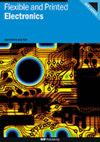Comparison of printing techniques for the fabrication of flexible carbon nanotube-based ammonia chemiresistive gas sensors
IF 3.2
4区 工程技术
Q3 MATERIALS SCIENCE, MULTIDISCIPLINARY
引用次数: 1
Abstract
Even though a plethora of printing technologies are currently available and their potential for the fabrication of low-cost and flexible sensors has been widely investigated, systematically based, and statistically sustained comparative studies are missing in the literature. In this work, we compare screen, inkjet, and dispense printing for the fabrication of carbon nanotube (CNT)-based ammonia (NH3) chemiresistive flexible gas sensors for the first time. Moreover, we report the first CNT-based gas sensor fabricated via Voltera printer. The devices were made of a thin layer of spray-coated CNTs and printed silver-based interdigitated electrodes. To draw a thoughtful comparison the same sensor layout, materials, and fabrication flow were used. The device morphological features were acquired through microscopic, atomic force microscope, and 3D images; additionally, the response to NH3 as well as the printing process characteristics for each technique was analyzed. From 300 µm nominal spacing between lines, we obtained a decrease of 25%, 13%, and 5% on the printed spacings with dispense, screen, and inkjet printing, respectively. At 100 ppm of NH3, a maximum response of 33%, 31%, and 27% with the dispense-, inkjet-, and screen-printed sensors were found, respectively. Statistical differences were observed between the mean values on the NH3 response of dispense- compared to the inkjet- and screen-printed sensors, which in effect showed the highest response in the Tukey test. This demonstrated that the fabrication technique employed can induce a different response mainly driven by the printed outcomes. Following a holistic approach that includes the sensor response, the application, the market perspective, and the process versatility, we suggest screen printing as the most suitable method for CNT-based NH3 gas sensor fabrication.柔性碳纳米管氨化学气体传感器的打印技术比较
尽管目前有大量的印刷技术可用,并且它们在制造低成本和柔性传感器方面的潜力已经得到了广泛的研究,但文献中缺乏基于系统和统计的持续比较研究。在这项工作中,我们首次比较了基于碳纳米管(CNT)的氨(NH3)化学电阻柔性气体传感器的丝网印刷、喷墨印刷和分配印刷。此外,我们报道了第一个通过Voltera打印机制造的基于CNT的气体传感器。该器件由喷涂的CNT薄层和印刷的银基叉指状电极制成。为了进行深思熟虑的比较,使用了相同的传感器布局、材料和制造流程。通过显微镜、原子力显微镜和三维图像获取器件的形态特征;此外,还分析了每种技术对NH3的响应以及印刷工艺特性。从300µm的标称线间距开始,我们获得了分配、丝网印刷和喷墨印刷的印刷间距分别减少了25%、13%和5%。在NH3浓度为100ppm时,分别发现分配传感器、喷墨传感器和丝网印刷传感器的最大响应为33%、31%和27%。与喷墨和丝网印刷传感器相比,在分配的NH3响应的平均值之间观察到统计差异,这实际上在Tukey测试中显示出最高的响应。这表明所采用的制造技术可以引起不同的响应,主要由印刷结果驱动。根据包括传感器响应、应用、市场前景和工艺多功能性在内的整体方法,我们建议丝网印刷是制造基于CNT的NH3气体传感器的最合适方法。
本文章由计算机程序翻译,如有差异,请以英文原文为准。
求助全文
约1分钟内获得全文
求助全文
来源期刊

Flexible and Printed Electronics
MATERIALS SCIENCE, MULTIDISCIPLINARY-
CiteScore
4.80
自引率
9.70%
发文量
101
期刊介绍:
Flexible and Printed Electronics is a multidisciplinary journal publishing cutting edge research articles on electronics that can be either flexible, plastic, stretchable, conformable or printed. Research related to electronic materials, manufacturing techniques, components or systems which meets any one (or more) of the above criteria is suitable for publication in the journal. Subjects included in the journal range from flexible materials and printing techniques, design or modelling of electrical systems and components, advanced fabrication methods and bioelectronics, to the properties of devices and end user applications.
 求助内容:
求助内容: 应助结果提醒方式:
应助结果提醒方式:


